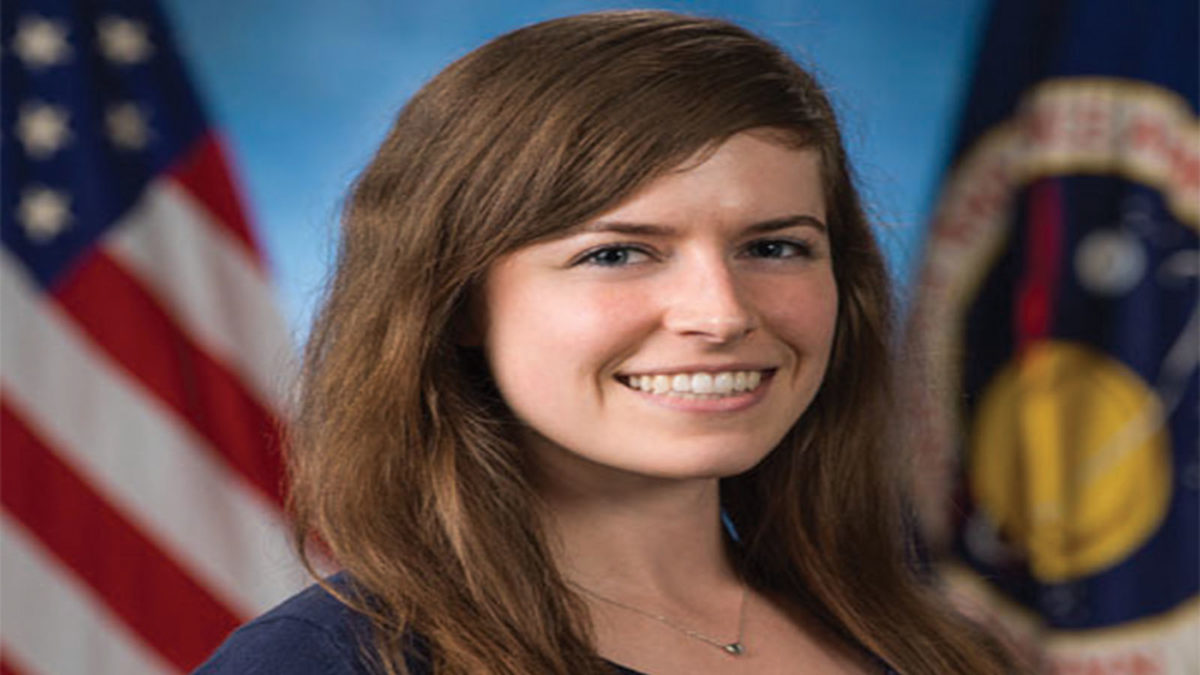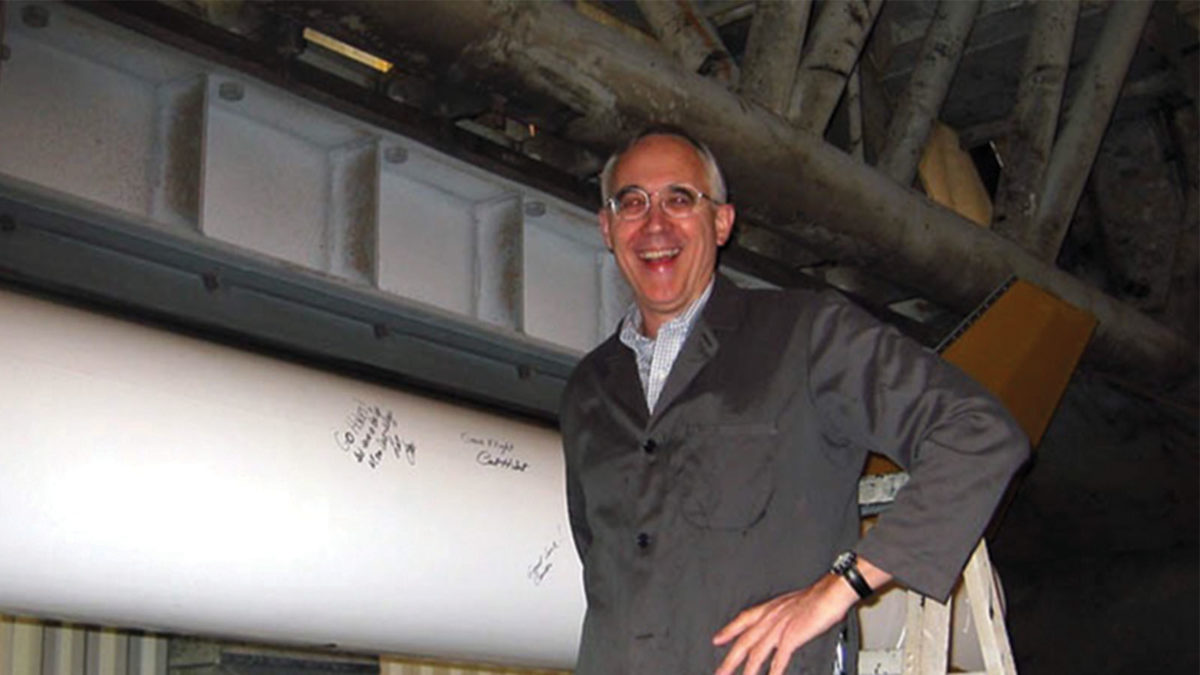- Making an Impact: Researching to Better Support Astronauts in Space
- 2019 AIAA Sustained Service Award Winners Announced
- AIAA Region VII-Australia Student Conference Winners Announced
- AIAA Associate Fellow Flomenhoft Died in August
- AIAA Fellow Hubert Died in October
- AIAA Fellow Rice Died in November
- AIAA Fellow Byers Died in November
Bulletin
AIAA Foundation Making an Impact: Researching to Better Support Astronauts in Space

The AIAA Foundation’s Neil A. Armstrong Graduate Award 2018 winner Emily Matula is preparing for a career to support and study life in space. Closer to home, she’s been training to become an EMT after seeing the need for medical assistance with Hurricane Harvey.
“A passion of mine is helping people, especially in crisis situations and I have always had an interest in medicine,” said Matula, a Ph.D. candidate at the University of Colorado Boulder, and a NASA Space Technology Research Fellow.
The EMT training has helped her become a better engineer. “In crisis situations, seconds are at stake, and no time to read an instruction manual or remember 30 different steps,” she said. “Making sure that an AED (automated external defibrillator) or ventilator is easy to use can be the difference between life and death.
“While long duration spaceflight missions are typically slower paced, they still require designs with streamlined usability to accommodate crews of all different disciplines. Exposure to these medical designs will help me to produce simpler aerospace solutions.”
Currently, Matula is taking a break from EMT training to head to Antarctica and collect algae samples to use in extremophile research. Her research supports Environmental Control and Life Support Systems (ECLSS), “making sure that the basic human metabolic needs of clean cabin air, drinking water, food, thermal control, waste remediation, and radiation protection are being met.”
She’s focused on using bioregenerative technologies—that’s where the algae come in––to provide simultaneous cabin air revitalization and thermal control.
“Algae typically grow in a water-based media, and water is currently being used by the International Space Station in its thermal loop to transport metabolic and experiment heat to the ammonia radiators. I hope to make a multi-functional system by using an algae photobioreactor to cool down the cabin, like the ISS thermal system, while also using algae’s photosynthesis to sequester respired CO2 and provide breathable oxygen.”
Ultimately, Matula would like to become program director of NASA’s Human Research Program (HRP).
She’s dreamed of becoming a scientist since she was a child in rural Ohio, home of clear starry nights. “I distinctly remember my dad waking me up at 4 in the morning, throwing coats and boots over pajamas, and laying down a large piece of cardboard for everyone to sit on and watch the Geminid meteor shower.”
Award Announcements 2019 AIAA Sustained Service Award Winners Announced
Congratulations to the following AIAA Sustained Service Award winners. Without their passion for aerospace engineering and science as well as their dedicated efforts, AIAA could not fulfill our mission to inspire and advance the future of aerospace.
Marty K. Bradley
Technical Fellow
Boeing Commercial Airplanes – Advanced Concepts
“For sustained, significant service at the national level with emphasis on Technical and Program/Integration Committee leadership, including formation of new committees.”
Timothy Dominick
Senior Principal Mechanical Engineer
Northrop Grumman Innovation Systems
“For sustained AIAA leadership at the section, region, and national committee levels attested by service to the Delaware Section and Public Policy Committee.”
Mark Melanson
Senior Manager for Integration and Infrastructure
Lockheed Martin Aeronautics (ret.)
“For his recognition of more than 24 years of Institute leadership including key contributions to the evolution of the New Event and Governance Models.”
Anthony M. Springer
Director, Integration and Management Office
Aeronautics Research Mission Directorate, NASA
“For decades of sustained service to the Institute in the areas of Membership, Technical Activities and Publications at all levels, from the Section to serving on the Board of Directors.”
Randy Truman
Professor
University of New Mexico
“For over 36 years of outstanding, exceedingly active, sustained service to AIAA as a Faculty Adviser, as well as involvement in Section leadership and participation in the Student Activities Committee.”
The Sustained Service Award recognizes an AIAA member who has shown continuing dedication to the interests of the Institute by making significant and sustained contributions over a period of time, typically 10 years or more. Please visit the AIAA Honors and Awards webpage (aiaa.org/HonorsAndAwards) for further information about this award. The 2019 Sustained Service Award deadline is 1 July 2019.
AIAA Student Programs AIAA Region VII-Australia Student Conference Winners Announced
The AIAA Region VII-Australia Student Conference took place 22–23 November 2018, at the University of Adelaide in Adelaide, Australia. The winners were:
1st place – Lloyd G. Button, University of Adelaide (The Effect of Corrosion-Inhibiting Compounds on the Mechanics of Fastened Aircraft Joints)
2nd place – Nahid A. Kermani and Con Doolan, University of New South Wales (The Effect of Splitter Plate(s) Attached with Square Cylinder in Turbulent Flow)
3rd place – Reece Otto and Shon Mori, University of Queensland (Concentrated Solar Power for Space Settlements)
The first-place winner is invited to compete in the AIAA International Student Conference, which will take place at the AIAA SciTech Forum in January.
Obituary AIAA Associate Fellow Flomenhoft Died in August
Hubert Ivan (Hugh) Flomenhoft, 93, died on 3 August 2018.
Dr. Flomenhoft attended Rensselaer Polytechnic Institute (RPI), where he received a Bachelor’s degree in Aeronautical Engineering, and the Massachusetts Institute of Technology (MIT) where he received a Master of Science degree. In 1961, he moved his family to Zurich, Switzerland, where he studied at the Federal Institute of Technology (ETH) and received his Doctorate in Science. He also served in the U.S. Navy during World War II.
Dr. Flomenhoft worked as an aeronautical engineer for his entire career, including managing the missile development for the PATRIOT missile system at the Raytheon Company. He was an Associate Fellow of AIAA and had been a member for over 70 years. After retiring he volunteered as a math tutor for high school students and published a book, The Revolution in Structural Dynamics, donating the proceeds to a special memorial fund at MIT.
Obituary AIAA Fellow Hubert Died in October

Dr. Carl H. Hubert died on 19 October, a week before one of the last projects that he worked on for NASA (the Dawn Mission) came to an end. He was 70.
Dr. Hubert received a B.S. from the State University of New York at Stony Brook and an M.S. and a Ph.D. from the Department of Theoretical and Applied Mechanics at Cornell University. Follow graduate school, he joined the technical staff of RCA’s Astro-Electronics Division, which ultimately became part of Lockheed Martin. In 1998, he left Lockheed Martin to start an independent consulting practice. Dr. Hubert participated in the design, analysis, and in-orbit operation of more than three dozen space vehicles for commercial, civil, and military programs. He authored 15 papers on spacecraft attitude dynamics and control and was awarded eight patents in the area of space vehicle control.
In May 2006, Dr. Hubert was diagnosed with Primary Lateral Sclerosis, which is a variant of Lou Gehrig’s disease. In 2010, he took early retirement. With the help of his partner, Judy DuBois, and family he was able to live at home until 2017, when he moved to Boston.
Over the course of his career, Dr. Hubert consulted with many companies/organizations, including Intelsat, NASA Jet Propulsion Laboratory, Johns Hopkins University Applied Physics Laboratory, NASA Goddard Space Flight Center, and Orbital Sciences, among others. For the Dawn Mission, he worked on the spinning upper state nutation dynamics (analyzed effect of heat pipes and technical lead for subscale drop tests of propellant tanks), extensive involvement in test program to determine the effect of rapid spin up/down on supercritical xenon. His work on the Lunar Reconnaissance Orbiter led NASA to switch the mission to an EELV with a three-axis stabilized upper state. And for the Messenger spacecraft, Dr. Hubert demonstrated that baffles were needed in the propellant tank to prevent nutation instability. His work on a major study for NASA Kennedy Space Center on nutation behavior of spinning space vehicles with onboard liquid propellant helped to identify and collect all available flight/test data and analyze, correlate, and combine it for future space programs. The resulting report is an important reference for NASA and its contractors.
An AIAA Fellow, Dr. Hubert was part of the Guidance, Navigation, and Control Technical Committee. In 1993, he won the AIAA Space Operations and Support Award: “For innovation and tenacity in successfully recovering the ANIK-E satellite from a potential mission-ending anomaly.”
Obituary AIAA Fellow Rice Died in November
Dr. Eric Rice died on 15 November. He was 74.
Dr. Rice attended college at the University of Wisconsin-Madison where he earned a B.S. in Chemistry (1967). He went on to Ohio State University where he obtained a Ph.D. in Aeronautical & Astronautical Engineering (1972).
During the 1970s and the early 1980s, Dr. Rice worked at Battelle in Columbus, Ohio, as a researcher and manager in the Space Systems and Applications sections. From 1984 to 1988, he was the Director of the Astronautics Technology Center in Madison, WI. In 1988, he founded Orbital Technologies Corporation (ORBITEC) with his business partners, Ron Teeter and Tom Crabb. He served as President, CEO, and Chairman at ORBITEC before he retired in 2014.
At ORBITEC, Dr. Rice led the development of a growing small aerospace business, which was acquired by Sierra Nevada Corporation (SNC) in 2014. Many of ORBITEC’s technologies are being integrated into SNC’s Dream Chaser Space Vehicle. Dr. Rice was involved in developing: future space mission concepts; advanced space lunar and Mars resources processing systems; advanced lunar transport and colonization system concepts, advanced chemical and electrical space propulsion, cryogenic solid hybrid propulsion, low-cost launch vehicle approaches; Mars colonization approaches; microgravity technologies for Space Station; commercial space vehicles, and future manned bases; advanced SRU based-propulsion for future space missions; bi-propellant liquid vortex and vortex-fed hybrid rocket engines; and advanced propellant systems.
An AIAA Fellow, Dr. Rice was involved with the Space Transportation Technical Committee (TC), the Microgravity and Space Processes TC, the Nuclear and Future Flight Propulsion TC, and the Space Colonization TC. He was also a member of the AIAA Commercial Space Group and the Corporate Member Committee.




